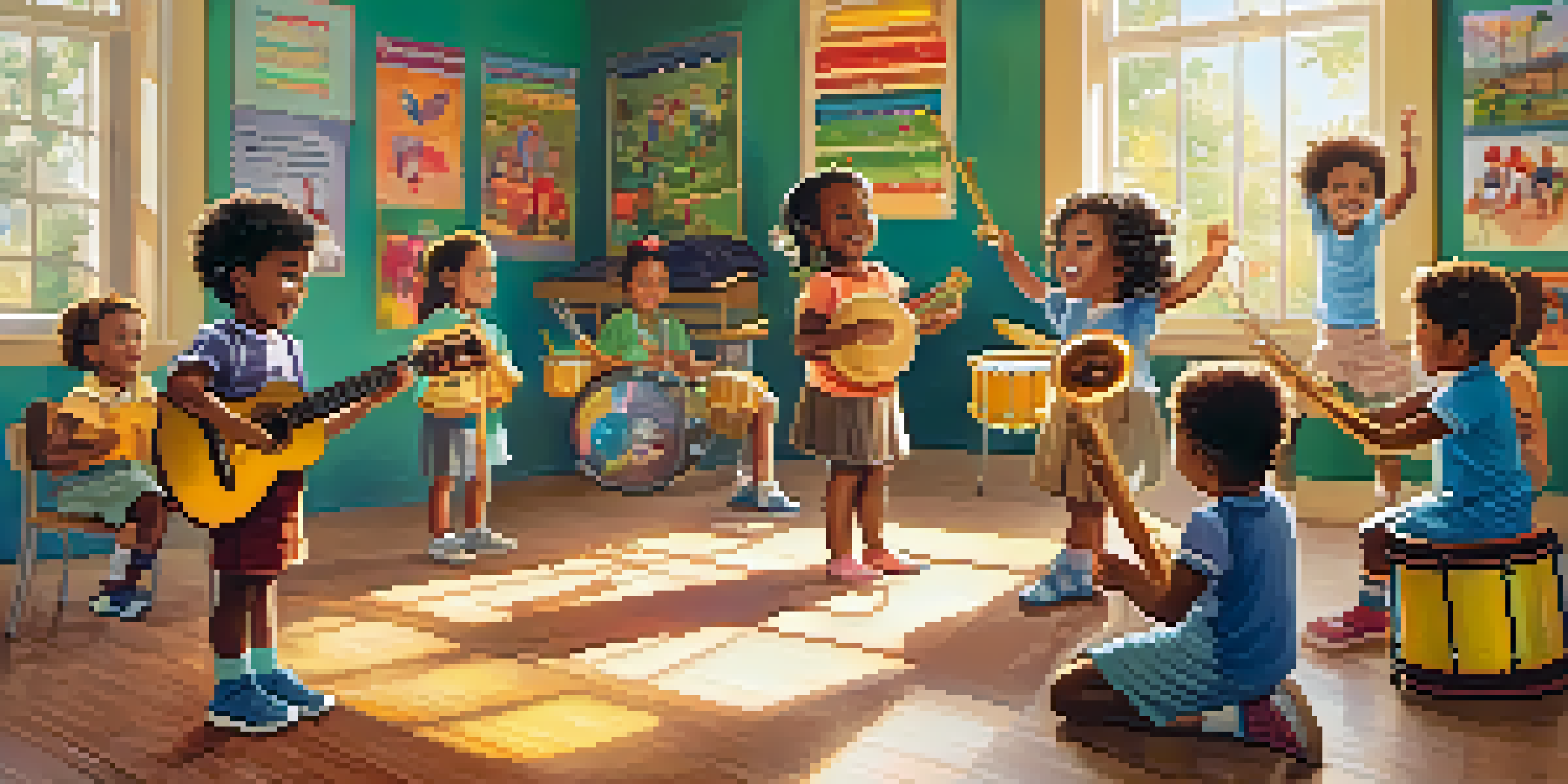The Influence of Music Education on Language Development in Children

Understanding the Connection Between Music and Language
Music and language share a fascinating relationship, both relying on patterns, rhythms, and sounds. When children engage with music, they're not just enjoying a melody; they're also honing their auditory skills. This foundational skill is crucial for language acquisition, as it helps kids distinguish between different sounds and tones.
Music can change the world because it can change people.
For instance, children learn to differentiate between a musical note and a spoken word, which enhances their overall listening abilities. This heightened awareness of sound can make it easier for them to pick up on the nuances of language, such as intonation and inflection. In essence, the more children immerse themselves in music, the more they strengthen their language-processing skills.
Moreover, music education often introduces children to new vocabulary and concepts. When they sing songs or learn about musical terms, they're not just having fun; they're expanding their linguistic capabilities in a creative way.
How Rhythm Supports Language Development
Rhythm is a key element in both music and language, acting as a bridge between the two. When children practice rhythm through clapping, drumming, or singing, they develop a sense of timing that is equally important for speech. This rhythmic ability allows them to break down words into syllables, making it easier to understand and articulate language.

For example, children who engage in rhythmic activities often find it easier to read aloud and pronounce words correctly. The rhythmic patterns in music mirror the prosody of spoken language, which helps kids grasp the flow and structure of sentences. By internalizing these patterns, they gain confidence in their spoken language skills.
Music Enhances Language Skills
Engaging with music helps children develop auditory skills that are crucial for language acquisition.
Additionally, engaging with rhythm can enhance memory, particularly when it comes to remembering lyrics and phrases. This can lead to improved recall in language tasks, such as vocabulary tests or storytelling, further solidifying the bond between music and language development.
The Role of Melody in Language Learning
Melody adds another layer of richness to the connection between music and language. The tunes we remember often linger in our minds long after we hear them, which helps reinforce language learning. When children learn songs, they are not just memorizing notes; they are also internalizing words and phrases.
Language is the road map of a culture. It tells you where its people come from and where they are going.
For instance, a catchy song can help children remember vocabulary or grammatical structures more effectively than traditional memorization techniques. Studies have shown that children who learn through song often retain information longer and can recall it with greater ease. This musical approach makes language learning feel less like a chore and more like an enjoyable experience.
Moreover, the emotional engagement that music provides can enhance motivation and interest in language. Children are more likely to explore new words and phrases when they associate them with melodies they love, creating a positive feedback loop for language acquisition.
Social Interaction Through Music and Language
Music education often takes place in group settings, fostering social interaction among children. This social aspect is crucial for language development, as it encourages kids to communicate with one another. When children sing together or participate in musical activities, they practice verbal skills in a fun and supportive environment.
For example, group singing can help children learn to express themselves verbally, negotiate roles, and collaborate on musical tasks. These interactions not only build their language skills but also develop essential social skills, such as empathy and teamwork. The joy of making music together creates a safe space for children to explore language without fear of judgment.
Rhythm Aids Speech Development
Practicing rhythm through music allows children to better articulate language by breaking down words into syllables.
Furthermore, these social experiences can lead to increased confidence in speaking. As children become more comfortable communicating through music, they often transfer that confidence to other language-related activities, such as reading aloud or participating in discussions.
Emotional Expression and Language Skills
Music provides a unique avenue for emotional expression, which is closely tied to language development. When children engage with music, they learn to identify and articulate their feelings, which is a vital component of effective communication. This emotional awareness can enhance their ability to express themselves verbally.
For instance, songs often convey stories or emotions, prompting children to discuss what they hear and feel. This engagement encourages them to use descriptive language, expanding their vocabulary and enhancing their storytelling abilities. As they learn to express complex emotions through music, they also become more adept at conveying those feelings in words.
Additionally, emotional engagement with music can lead to deeper connections with language. When children feel something profoundly while listening to a song, they are more likely to remember the words and phrases associated with those emotions, reinforcing their language skills in the process.
Cognitive Benefits of Music Education for Language Skills
Engaging in music education can lead to a variety of cognitive benefits that positively impact language development. Learning to play an instrument, for example, requires focus, discipline, and memory—all skills that translate well to language learning. Children who participate in music education often show improvements in their overall cognitive abilities, including problem-solving and critical thinking.
As children learn to read music and understand musical notation, they are simultaneously developing their analytical skills. These skills can help them decode written language, making it easier to read and comprehend texts. Moreover, the mental multitasking required in music—such as coordinating between notes, rhythms, and lyrics—can enhance executive function and attention, which are essential for language tasks.
Emotional Expression Boosts Language
Music encourages children to articulate their emotions, enhancing their verbal communication and vocabulary.
Furthermore, the cognitive load of learning music helps strengthen neural connections in the brain. This increased brain activity lays a strong foundation for various forms of learning, including language acquisition, making music education an invaluable tool for young learners.
Practical Strategies for Integrating Music into Language Learning
Incorporating music into language learning can be both fun and effective. Simple strategies like singing songs during lessons, using rhymes, or creating musical games can engage children and enhance their language skills. For instance, educators can use familiar tunes to teach new vocabulary, making the learning process enjoyable.
Parents can also play a role by introducing music at home. Singing lullabies, playing interactive music, or even encouraging children to create their own songs can spark interest in language. This playful approach allows kids to explore language in a relaxed setting, promoting a love for learning.

Additionally, technology offers new avenues for integrating music into language education. Apps and online resources that combine music with language exercises can further enrich children's learning experiences, providing them with an engaging way to practice their skills anytime and anywhere.